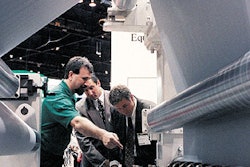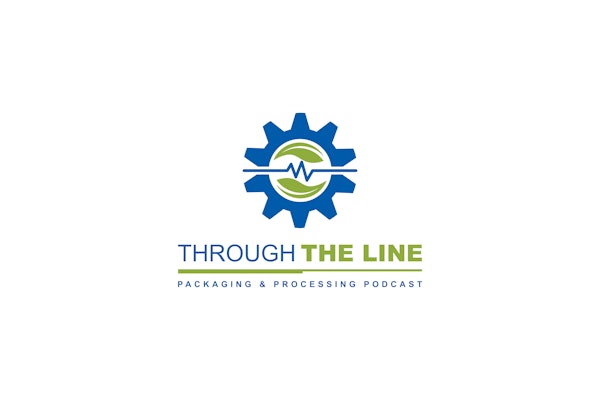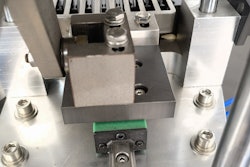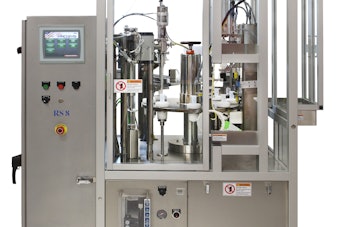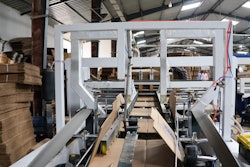In an effort to meet a tight production deadline for Boniva's 2005 introduction, Roche selected a five-panel polypropylene wallet pack for the once-per-month tablet (It's also available in a prefilled syringe.).
"After the product was launched, we worked with a cross-functional team that included marketing and engineering staff to investigate the feasibility of using more environmentally friendly material," says Carmen Corrado, vice president of pharmaceutical manufacturing for Roche. "However, we had to keep in mind that not only were we looking for environmentally friendly material, but also maintaining the child-resistant feature of the current package design. So we had to make sure that while we were addressing one concern, we were not compromising another."
The blister is encased in the wallet, which also contains the printed package insert. The wallet is folded, closed, and placed into a fiberboard carton with a physician insert. Within the wallet pack is a patient package insert printed on a folded pamphlet. The tablet is within a blister in the pack. The trade package contains three wallets, which are dispensed to the patient. The patient's insurance approves either a one-month or three-month supply of the drug.
"We transitioned from the polypropylene to a laminated fiberboard design that was more environmentally friendly and less costly," says Corrado. "In addition to redesigning the wallet card, we redesigned the patient package insert, which was initially printed in a booklet format on an expensive, glossy paper. We selected a less-expensive paper stock," a thinner, virgin paper material.
Corrado contends that the new materials are more environmentally friendly because of their fiberboard composition. "There are some municipalities that do not have the provision for [recycling] polypropylene. I'm not implying all municipalities fall into this category, however, I would imagine that more have programs to recycle fiberboard materials," he says.
Regardless of the material, isn't Roche using a considerable amount of packaging for one tablet? "I don't believe so," says Corrado. "What is driving this package are stringent child-resistant features and the need to maintain the patient package insert within the wallet design. The packaging is designated F=1, the most stringent Child-Resistance [CR] designation.
"Balancing all the pack's needs is a daunting task. It requires considerable testing, both in terms of package functionality and performance characteristics, and in its machineability on the packaging line. Materials have to maintain appropriate child-resistance while also being easy to open for the patient." All materials for the Boniva package are sourced locally, although the company prefers not to divulge supplier details or material specifications.
Corrado says that material changes do not require revalidation by the U.S. Food and Drug Administration. "However," he notes, "equipment changes to support the redesigned packaging components required factory acceptance testing at our vendors' facilities to ensure that the changes specified in our user requirements are achieved by the vendor. Once the factory acceptance testing was successfully completed, the equipment was shipped to our plant in Nutley. Upon receipt, the equipment went through extensive site acceptance testing followed by equipment qualification runs prior to use for commercial operations."
Data from all testing is retained on file for future FDA inspections, "if they deem it necessary," says Corrado, who points out that the redesigned Boniva package was introduced into the marketplace in January 2007.
Machinery modifications
At the Nutley facility, a blister-packaging machine is employed for Boniva's primary packaging, followed by a cardfolder for the product's wallet, and a cartoner that inserts the wallet pack and a physician insert into a sealed carton.
So, what modifications were made for Roche's Boniva packaging equipment to accommodate the material changes? Corrado explains, "We retooled our existing equipment. When we were finished, the equipment was basically like new. We had to design-not redesign-the cartoner's equipment transfer buckets to accommodate this five-panel wallet as we transitioned from a semi-automatic to an automatic cartoning process. We also had to install a new feed system on the cartoner to accommodate the placement of one or three wallets per carton.
"As far as the basic wallet machine, the equipment frame and drive shaft were extended to accommodate a new vision system and a laser printer. In addition, we had to redesign the feed mechanisms for the card and patient insert," he says.
Material savings, boost in OEE
Corrado says the modifications took nearly a year to make. "They required extensive dialogue with the equipment suppliers. In order to successfully accomplish this, we had to enlist the support of our component vendors and the equipment manufacturers."
Did all the effort pay off in the Boniva relaunch? Corrado explains, "We derived savings primarily from the wallet and the patient package insert material changes. With the wallet packs, we were able to reduce our cost by approximately 50 percent, and with the patient package insert, we were able to reduce our cost by approximately 65 percent."
Since making the change, Corrado says there's been a significant improvement in the packaging line's Overall Equipment Effectiveness. "Our OEE is a key indicator used to measure line performance. This in turn highlights the quality and the waste generated during the operation. So we saw a significant improvement in our blister-packing and cartoning operations when we made these changes. We saw a considerable increase in our OEE. We were operating somewhere between 50 and 55 percent," he says, which is an impressive figure in the pharmaceutical sector. "Now our OEE is up to 84 percent. We are exceeding our expectations in our Boniva packaging operation. This is due to people taking ownership, responsibility, and pride in their particular operation."
Beyond the impressive OEE figures, the changes are somewhat transparent to Boniva patients. "We haven't received any feedback to my knowledge from the consumers or the trade," Corrado admits, but he believes strongly in Roche's sustainability stand. "We are constantly looking at opportunities to improve our packaging operations and to utilize more environmentally friendly materials that are safe for the consumers. Roche believes that economic success, as well as social responsibility and environmental protection, are dynamically interrelated. We strive to balance this in everything we do, and we look at packaging as an important part of this process."
--By Jim Butschli, Editor
Read the accompanying sidebar, Roche's six sigma approach.
"After the product was launched, we worked with a cross-functional team that included marketing and engineering staff to investigate the feasibility of using more environmentally friendly material," says Carmen Corrado, vice president of pharmaceutical manufacturing for Roche. "However, we had to keep in mind that not only were we looking for environmentally friendly material, but also maintaining the child-resistant feature of the current package design. So we had to make sure that while we were addressing one concern, we were not compromising another."
The blister is encased in the wallet, which also contains the printed package insert. The wallet is folded, closed, and placed into a fiberboard carton with a physician insert. Within the wallet pack is a patient package insert printed on a folded pamphlet. The tablet is within a blister in the pack. The trade package contains three wallets, which are dispensed to the patient. The patient's insurance approves either a one-month or three-month supply of the drug.
"We transitioned from the polypropylene to a laminated fiberboard design that was more environmentally friendly and less costly," says Corrado. "In addition to redesigning the wallet card, we redesigned the patient package insert, which was initially printed in a booklet format on an expensive, glossy paper. We selected a less-expensive paper stock," a thinner, virgin paper material.
Corrado contends that the new materials are more environmentally friendly because of their fiberboard composition. "There are some municipalities that do not have the provision for [recycling] polypropylene. I'm not implying all municipalities fall into this category, however, I would imagine that more have programs to recycle fiberboard materials," he says.
Regardless of the material, isn't Roche using a considerable amount of packaging for one tablet? "I don't believe so," says Corrado. "What is driving this package are stringent child-resistant features and the need to maintain the patient package insert within the wallet design. The packaging is designated F=1, the most stringent Child-Resistance [CR] designation.
"Balancing all the pack's needs is a daunting task. It requires considerable testing, both in terms of package functionality and performance characteristics, and in its machineability on the packaging line. Materials have to maintain appropriate child-resistance while also being easy to open for the patient." All materials for the Boniva package are sourced locally, although the company prefers not to divulge supplier details or material specifications.
Corrado says that material changes do not require revalidation by the U.S. Food and Drug Administration. "However," he notes, "equipment changes to support the redesigned packaging components required factory acceptance testing at our vendors' facilities to ensure that the changes specified in our user requirements are achieved by the vendor. Once the factory acceptance testing was successfully completed, the equipment was shipped to our plant in Nutley. Upon receipt, the equipment went through extensive site acceptance testing followed by equipment qualification runs prior to use for commercial operations."
Data from all testing is retained on file for future FDA inspections, "if they deem it necessary," says Corrado, who points out that the redesigned Boniva package was introduced into the marketplace in January 2007.
Machinery modifications
At the Nutley facility, a blister-packaging machine is employed for Boniva's primary packaging, followed by a cardfolder for the product's wallet, and a cartoner that inserts the wallet pack and a physician insert into a sealed carton.
So, what modifications were made for Roche's Boniva packaging equipment to accommodate the material changes? Corrado explains, "We retooled our existing equipment. When we were finished, the equipment was basically like new. We had to design-not redesign-the cartoner's equipment transfer buckets to accommodate this five-panel wallet as we transitioned from a semi-automatic to an automatic cartoning process. We also had to install a new feed system on the cartoner to accommodate the placement of one or three wallets per carton.
"As far as the basic wallet machine, the equipment frame and drive shaft were extended to accommodate a new vision system and a laser printer. In addition, we had to redesign the feed mechanisms for the card and patient insert," he says.
Material savings, boost in OEE
Corrado says the modifications took nearly a year to make. "They required extensive dialogue with the equipment suppliers. In order to successfully accomplish this, we had to enlist the support of our component vendors and the equipment manufacturers."
Did all the effort pay off in the Boniva relaunch? Corrado explains, "We derived savings primarily from the wallet and the patient package insert material changes. With the wallet packs, we were able to reduce our cost by approximately 50 percent, and with the patient package insert, we were able to reduce our cost by approximately 65 percent."
Since making the change, Corrado says there's been a significant improvement in the packaging line's Overall Equipment Effectiveness. "Our OEE is a key indicator used to measure line performance. This in turn highlights the quality and the waste generated during the operation. So we saw a significant improvement in our blister-packing and cartoning operations when we made these changes. We saw a considerable increase in our OEE. We were operating somewhere between 50 and 55 percent," he says, which is an impressive figure in the pharmaceutical sector. "Now our OEE is up to 84 percent. We are exceeding our expectations in our Boniva packaging operation. This is due to people taking ownership, responsibility, and pride in their particular operation."
Beyond the impressive OEE figures, the changes are somewhat transparent to Boniva patients. "We haven't received any feedback to my knowledge from the consumers or the trade," Corrado admits, but he believes strongly in Roche's sustainability stand. "We are constantly looking at opportunities to improve our packaging operations and to utilize more environmentally friendly materials that are safe for the consumers. Roche believes that economic success, as well as social responsibility and environmental protection, are dynamically interrelated. We strive to balance this in everything we do, and we look at packaging as an important part of this process."
--By Jim Butschli, Editor
Read the accompanying sidebar, Roche's six sigma approach.




